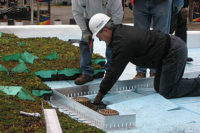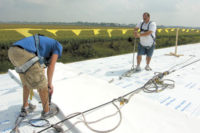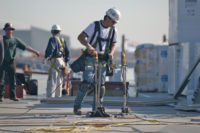Maybe you’ve heard the term “resilient” or “resiliency” used for buildings recently. The term is being used in the wake of recent natural disasters as a performance objective for commercial, industrial and residential construction. Resiliency, loosely defined, is the ability of a building to withstand extreme weather events and remain habitable and useful.
The roofing industry can play a big part in building resiliency. If the roof is damaged or blows off in a weather event, it’s quite likely the building will be uninhabitable or unusable after a storm. This is certainly true for single-story and low-rise buildings. And it’s very likely true for multi-story buildings, whether office or residential.
What are the nuts and bolts of a resilient roof system? Wind resistance, impact resistance, daylighting, insulation, roof color and rooftop energy productions are all important elements.
Wind resistance and impact resistance are necessary for continued weatherproofing during and after a storm. A resilient roof system can be designed for a wind speed higher than code requires for the location of the building. Adding 10 or 20 mph to the design wind speed will increase the design loads. Subsequently, designing to the increased loads will achieve a roof system that will be more capable of resisting high winds. Roof edges are critical for resiliency. The roofing industry knows that most roof blow-offs start at corners and perimeters. In addition to an appropriate metal edge or parapet detail, adding a well-fastened and weatherproofed termination bar close to the metal edge or parapet is a secondary measure. This helps keep a roof in place by preventing a progressive failure if the edge metal is blown off during a storm. (See Figure 1.) More on wind design for roofs is available at www.wbdg.org/resources/env_wind.php?r=env_roofing.
Depending on the type of storm, debris or hail may impact the roof system. A durable, tough cover board helps prevent damage from debris and hail. (A cover board is also a thermal break for mechanically attached insulation.) The tougher the substrate directly beneath the membrane, the more impact resistant the membrane will be. For example, a roof system’s impact resistance is improved when a gypsum cover board is included.
There are ways a roof can help the occupants not only inhabit a building or residence after a severe weather event, but also keep them more comfortable and productive.
Roof insulation and roof color play an important role in occupancy comfort after a storm when the power is out. An insulation layer with high R-value means less transfer of heat/energy into or out of a building; therefore a more suitable interior temperature can be maintained. A roof’s color — white or black or somewhere in the middle — will determine if the sun’s energy is reflected or absorbed. Location, climate, building use and the conditioning of a building (e.g., heated only) will help determine the most resilient roof-color choice. Unfortunately, we can’t predict if a potentially debilitating storm will happen in winter or summer.
When the power is out and lights are not working, rooftop daylighting systems can provide the necessary amount of light for occupants to function reasonably well. Roof system designers must consider the tradeoff between daylighting and the loss of R-value, as well as the impact resistance of the daylighting system.
For longer-term building resiliency, energy production (from photovoltaic or wind power systems) can be included on a rooftop. Rooftop energy production (aka, distributed generation) can operate key components of a building during a power failure. It’s important to realize that grid-tied PV systems without battery back up will not provide energy during a black out; a functioning grid is needed for a PV system without energy storage capacity. Consider the cost to a grocery store when loss of power means throwing away aisles of refrigerated and frozen food. A battery-backup PV system might well be worth the cost.
Given the new motivation for resilient building design, a resilient roof system can play an important role for continued occupancy and use of buildings that have gone through a significant weather event.
Roof designers can find much more information about enhanced durability and high-quality roof system design in the RoofPoint™ Guideline, which can be downloaded at www.roofpoint.org. Special thanks go to the Roofing Industry Alliance for its continued support of RoofPoint.





